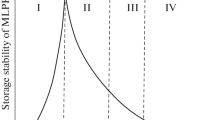Abstract
PMUF resins which gave poor performance on salts-treated fire retardant veneers were upgraded by several systems of molecular doubling directly in the glue-mix to solve the problem. This type of solution was deemed necessary from the basic investigation pinpointing the problem. The problem was found to be that heavy salts coatings of the veneer instead of stopping veneer surface wetting by the adhesive instead increased excessively adhesive penetration changing completely the rheology of the system. Increasing the degree of poly-merisation of the resin was the generalised solution to the problem. This however cannot be done at the resin manufacturing stage as too short shelf-lifes ensue. It was done by the use of very reactive additives added exclusively in the glue-mix. Among these additives the addition of a few percentages (6%–8%) tannin on resin solids proved to be the most successful, and gave good results for PMUF bonding of fireproof plywood. The upgrading of the resin in this manner also allowed bonding of treated veneers of wood species which could not be bonded at all with the standard PMUF resin.
Zusammenfassung
Die Eigenschaften von PMUF-Harzen für Furniere, die mit Feurschutzsalzen behandelt wurden, konnten auf mehrere Arten verbessert werden, indem verschiedene Mengen an Tannin oder PMDI zur Klebermischung zugegeben wurden. Diese Lösung war durch Vorversuche als erfolgversprechend ermittelt worden. Dabei hatte sich gezeigt, daß das Problem nicht darin bestand, daß die Furnieroberfläche durch die Feuerschutzsalze weniger benetzbar wird, sonden im Gegenteil, daß die Eindringung des Klebers drastisch eröhlt war, weil die Theologischen Verhältnisse völlig verändert waren. Eine Erhöhung des Polymerationsgrades war demnach nötig. Dies konnte jedoch nicht schon beim Herstellen der Harze erfolgen, weil dadurch zu kurze Topfzeiten entstanden wären. Die Lösung wurde durch Zugabe sehr reaktionsfähiger Komponenten zur Harzmischung erreicht. Dabei erwies sich der Zusatz von 6–8% Tannin (bezogen auf Festharz) als besonders erfolgreich beim Verkleben zu Feuerschutzsperrholz. Mit diesen verbesserten Harzen konnten auch behandelte Furniere aus solchen Holzarten verleimt werden, die mit Standard PMUF-Harzen nicht gebunden werden konnten.
Similar content being viewed by others
References
European Norm UNI EN314, pretreatment 5.1.3 for exterior plywood (1995)
Higuchi, M.; Roh, J.-K.; Tajima, S.; Irita, H.; Honda, T.; Sakata, I. 1994: Polymeric structures of Melamine-based composite adhesives, in Chapter 6, Adhesives and Bonded Wood Products (C.-Y. Hse, B. Tomita and S. J. Branham, Eds.), Forest Products Society, Madison, Wisconsin, 429–449
Meyer, B. 1979: Urea-formaldehyde resins, Addison-Wesley, Reading, Massachussets.
Pizzi, A. 1981: A new series of tannin adhesives for exterior particleboard, Int. J. of Adhesion and Adhesives, 2: 261–265
Pizzi, A. 1982: Pine tannin adhesives for particleboard, Holz Roh Werkstoff, 40: 293–299
Pizzi, A. 1994: Advanced Wood Adhesives Technology, Dekker, New York
Pizzi, A.; Stephanou, I.; Antunes, I.; Beer, G. De 1993: Alkaline PF resins linear extension by urea condensation with hydroxybenzylalcohol groups, J. Appl. Polymer Sei. 50: 2201–2207
Pizzi, A.; Valenzuela, J.; Westermeyer, C. 1993: Non-emulsifiable, water-based diisocyanate adhesives for exterior plywood, Part 2, Holzforschung, 47 (1): 69–72
Pizzi, A.; Walton, T. 1992: Non-emulsifiable, water-based diisocyanate adhesives for exterior plywood, Part 1, Holzforschung, 46 (6): 541–547
Rossouw D.; Rossouw, T.; Pizzi, A.; McGillivray, G. 1980: The kinetics of condensation of phenolic polyflavonoid tannins with aldehydes, J. Polymer Sei., Chem. Ed., 18 (12): 3323–3334
Tomita, B.; Ohyama, M.; Hse, C.-Y. 1994: Synthesis of phenolurea-formaldehyde cocondensed resins from UF concentrate and Phenol, Holzforschung, 48 (6): 522–526
Author information
Authors and Affiliations
Rights and permissions
About this article
Cite this article
Cremonini, C., Pizzi, A. & Tekely, P. Improvement of PMUF adhesives performance for fireproof plywood. Holz als Roh- und Werkstoff 54, 43–47 (1996). https://doi.org/10.1007/s001070050130
Issue Date:
DOI: https://doi.org/10.1007/s001070050130




